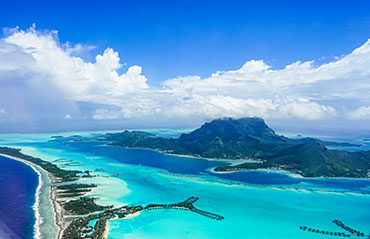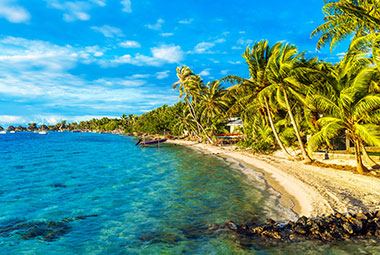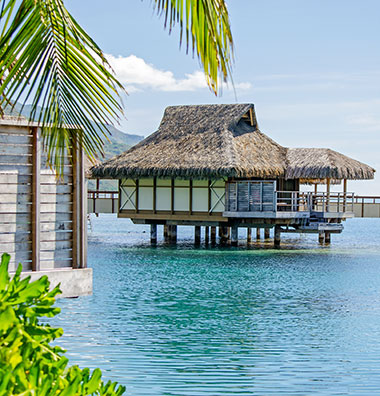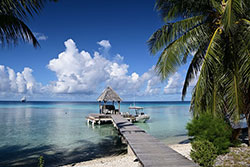Travel > Oceania > French PolynesiaFrench PolynesiaIsland Gems of French Polynesia:Imagine stepping off the plane, the warm caress of Polynesian air enveloping you as you breathe in the scent of plumeria and distant ocean spray. Crystal-clear turquoise waters lap at pristine beaches, Lush mountains rise majestically, while gentle waves beckon you to kayak through lagoons teeming with colorful fish and playful dolphins. French Polynesia offers a paradise of unforgetable experiences. Whether you crave the heart-pounding thrill of surfing legendary waves in Tahiti, the luxurious indulgence of an overwater bungalow in Bora Bora, or the serenity of snorkeling alongside majestic manta rays in Rangirgoa, this archipelago delivers. Dive into the rich tapestry of Polynesian culture, from the vibrant dance rhythms of Heiva i Tahiti to the captivating stories whispered by ancient marae in Moorea. Escape the beaten path in Fakarava, a UNESCO Biosphere Reserve where nature reigns supreme, or travel back in time to the cradle of Polynesian civilization in the remote Marquesas Islands. French Polynesia awaits, ready to weave its magic into your soul. Are you ready to answer its call? Tahiti:
Bora Bora:
Moorea:
Rangiroa:
Fakarava:
Marquesas Islands:
Best Time to Visit:The best time to visit French Polynesia depends on what you're looking for in your trip. Here's a brief overview of the seasons and what to expect:High Season (June - August): Weather: Dry and sunny, with average temperatures in the high 70s to low 80s Fahrenheit (mid 20s to low 30s Celsius). This is the most popular time to visit, so expect crowds and higher prices. Shoulder Season (May and September): Weather: Pleasant temperatures, with occasional showers. Average temperatures range between 75 - 78 Fahrenheit (24 - 26 degrees Celsius) This is a good time to visit if you want to avoid the crowds and high prices of peak season. Low Season (November to April): Weather: Warm and humid, with more frequent rain showers. Temperatures average between 80 - 84 Fahrenheit (27 - 29 degrees Celsius). This is the least crowded time to visit, and you can find the best deals on flights and accommodations. However, some water activities may be limited due to rougher seas. Ultimately, the best time to visit French Polynesia is whenever it best suits your interests and budget. Transportation:Flights to French Polynesia: The most common way to get to French Polynesia is by flying into Faa'a International Airport (PPT) on the island of Tahiti. There are no direct flights from most major cities in the United States, so you will likely have to make a connection in Los Angeles, San Francisco, or Auckland, New Zealand. Several airlines offer flights to Tahiti, including Air Tahiti Nui, Air France, United Airlines, and New Zealand Airlines. Be sure to book your flights well in advance, especially if you are traveling during peak season (June-August and December-January). Ferries: Once you are in Tahiti, you can take a ferry to other islands in French Polynesia and they can be a more affordable option than flying. The journey between Tahiti and Moorea takes about 30 minutes by ferry, but it only takes 15-20 minutes by plane.The most popular ferry route is between Tahiti and Moorea. There are two main ferry companies in French Polynesia: Terevau and Aremiti. Be sure to book your flights and ferry tickets in advance, especially if you are traveling during peak season. Car rentals: If you want to explore Tahiti or Moorea at your own pace, you can rent a car. There are several car rental companies in Tahiti and Moorea, including Avis, Budget, and Hertz. Be aware that car rentals can be expensive in French Polynesia. Buses:The bus system in Tahiti is called Le Truck. Public buses are a cheap way to get around Tahiti and Moorea, but they can be slow and crowded. Buses run between most major towns and villages on Tahiti and Moorea. Allow plenty of extra time for travel, as transportation can be unreliable in French Polynesia. Where to Stay:French Polynesia islands each offer unique experiences and a vast array of accommodation options to suit every taste and budget. Whether you seek ultimate luxury, immerse yourself in nature, or experience local culture, here's a breakdown of the types of accommodations you'll find in French Polynesia: Overwater Bungalows: Bora Bora's iconic image, these stilted havens perched above crystal-clear lagoons offer the epitome of luxury with private plunge pools, direct access to the ocean, and unparalleled views. Luxury Resorts: Pamper yourself in opulent beachfront resorts featuring world-class spas, gourmet dining, and a plethora of activities, from water sports to cultural excursions. Boutique Hotels: Immerse yourself in the charm and personalized service of smaller hotels, many catering to eco-conscious travelers with sustainable practices. Family-Friendly Resorts: Find spacious accommodations, dedicated kids' clubs with supervised activities, multiple pools, and watersports facilities, ensuring an unforgettable vacation for the whole family. Eco-Lodges and B&Bs: Rustic yet comfortable accommodations nestled in lush landscapes or local villages offer an authentic cultural experience and a chance to reconnect with nature. Homestays: Immerse yourself in the heart of local life by staying in family-run homestays, enjoying traditional meals and gaining insights into Polynesian culture. Vacation Rentals: Find privacy and spacious living in private villas or vacation homes, ideal for groups or extended stays. Camping: Pitch a tent under the starry sky on designated campsites, perfect for budget-conscious travelers seeking an adventurous experience. Remember, this is just a glimpse into the diverse accommodation landscape of French Polynesia. With its rich cultural heritage and stunning natural beauty, this island paradise promises an unforgettable stay, regardless of your chosen accommodation style. Safety Tips:While French Polynesia boasts stunning beauty and generally low crime rates, here are some essential safety tips for a smooth and enjoyable trip:
|
 Bora Bora Bora BoraPhoto by Angela Meier / Adobe Stock  Bora Bora Bora BoraPhoto by Ggfoto / Adobe Stock  Bungalow in Bora Bora Bungalow in Bora BoraPhoto by Marcorubino / Adobe Stock | |||||||||||||||||||||||||
 Thomas / Adobe Stock
Thomas / Adobe Stock  XiSerge / Pixabay
XiSerge / Pixabay